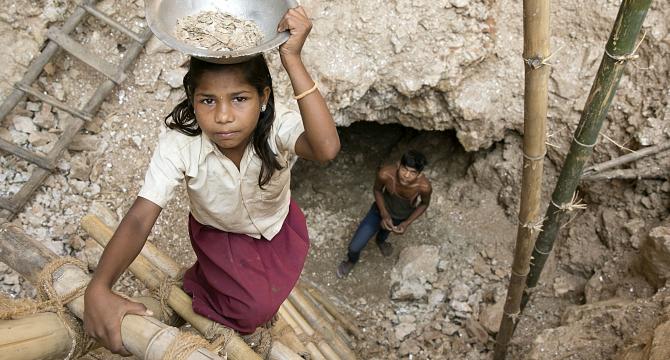
ARIANA JESSA – NOVEMBER 6TH, 2018
Child labour is often a term we see smeared across a sensational news piece, denouncing governments for infringing on human rights. Yet, despite the moral objections, it is still common practice in many countries today. Some argue that the practice enhances economic growth. If society chooses to stand on the shoulders of children in the name of economic growth, there must be overwhelming material benefits for the wider society. However, this is not the case, as child labour actively detracts from economic development, which, when compounded with human rights concerns, should be abolished.
Child labour is defined by the International Labour Organization (ILO) as the work of an individual under the age of 14 that detracts or acts as a substitute for education. In practice this looks like children working in factories, likely in low-skilled manufacturing jobs. The main argument for child labour in developing economies try to spin the practice as an opportunity for children to “grow”. This is backed by the theory that it allows younger individuals to support their families and gain work experience before they transition into the workforce. In theory, this makes society at a production level, more effective, while also breaking the poverty cycle. However, this is far from reality. In fact, child labour inhibits skill development and limits the expansion of local labour markets, effectively stunting economic growth. In Egypt, Jackline Wahba (2006) shows that the children of child laborers are 10 percent more likely to be child laborers themselves, holding everything else equal. This already demonstrates that in the long term, child labour does not bring people out of poverty, it reinforces it.
The work the child does, given the scarcity of their time and energy, inevitably ends up stifling both their physical and intellectual development. This limits the child’s ability to cultivate skills that will help them get them a higher paying job with better working conditions. What this inevitably leads to is a lack of social mobility that comes only with education and skills training, which perpetuates intergenerational child labour. This has implications beyond the child’s future family, as a large demographic of low-skilled workers in the labour force prevents development of economies that rely on resource and manufacturing industries into one which is more profitable, where higher skilled and more service based industry is relied upon. This is essential to development, and cannot occur in a system which endorses child labour.
The influx of labour, especially young and impressionable kids, drives wages down, because there are more more individuals willing to work at a given wage, and this increased competition for jobs drives down wages. Some children work 12 hour days for 20 cents per day, which is significantly less money than their adult counterparts are will to be paid, and companies will be incentivized to hire youth because of this. This then perpetuates its own cycle: child labour leads to lower wages, which leads to the need of families to get their children employed. Parents who earn under living wage are most likely to send their children to work.The abundance of unskilled workers creates a society which complements technology that does not required skilled management. This is because low skilled workers cannot become specialized due to their lack of education, which limits the efficiency needed to create more high volume, high technologically reliant industries. The more child labour there is, the more unskilled industry is perpetuated in an economy, which results in lower demand for countries to adopt technologies that utilize high skilled labour. Richard Hornbeck and Suresh Naidu (2014) show that the prevalence of unskilled, low-wage black labor in the American South delayed the modernization of agriculture and hindered agricultural development. This demonstrates that an abundance and a reliance on low skilled labour, which is more likely in a society with child labour, slows down economic progress. Because of child labour, human capital cannot accumulate as it has in countries without it, which stunts development.
Developing economies would benefit greatly from strictly regulating the practice of child labour in their country. The ramifications that inhibiting youth development has on intergenerational poverty, and the development of industry, far outweigh marginal benefits that can be gained from child labour. Standing on the shoulders of children is not only an abhorrent practice, but one that inhibits societal growth and economic development in its totality.
Featured Image Source: Terre Des Hommes
Disclaimer: The views published in this journal are those of the individual authors or speakers and do not necessarily reflect the position or policy of The Berkeley Economic Review staff, the Undergraduate Economics Association, the UC Berkeley Economics Department and faculty, or the University of California at Berkeley in general.



